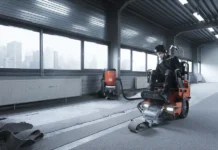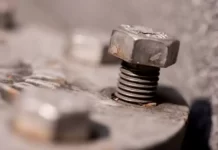Key Takeaways:
- Industrial clutch systems play a crucial role in transmitting power and torque between the engine and driven machinery.
- Industrial clutch systems help control engagement and disengagement of power, preventing damage to machinery and operators.
- Advancements in industrial clutch technology include hydraulic and pneumatic clutch systems, advanced friction materials, and optimized clutch design.
- Choosing the right clutch system requires considering torque capacity, operating environment, and engagement requirements.
- WPT clutch systems use patented air tube disc clutch technology for consistent and durable engagement.
- The benefits of using WPT clutch systems include enhanced performance, increased durability, reduced maintenance, improved safety, and cost savings.
- WPT clutch systems have been successfully deployed in construction, mining, marine, and other industries.
- To maximize clutch system performance, regular maintenance, proper alignment, and consideration of operating conditions are necessary.
- Upgrading clutch systems with electronic controls, remote monitoring, system integration, and energy efficiency improvements can enhance efficiency and productivity.
- Future innovations in clutch system technology include intelligent clutch systems, lightweight materials, electric clutches, and condition monitoring.
- Industrial clutch systems contribute to sustainable manufacturing through energy efficiency, waste reduction, and increased productivity.
- Anticipated advances in WPT clutch systems include increased torque capacity, smarter controls, enhanced environmental resistance, and expansion into new industries and applications.
Introduction to Industrial Clutch Systems
In the world of machinery, the performance and efficiency of various components are vital for seamless operation. One such crucial component is the industrial clutch system. Industrial clutch systems play a crucial role in transmitting power and torque between the engine and the driven machinery, allowing for controlled engagement and disengagement of power. They are commonly used in industries such as construction, mining, marine, agriculture, and many others where heavy-duty equipment is involved. Understanding the importance of industrial clutch systems and choosing the right system for your application is essential for maximizing productivity and ensuring safe and reliable operation.
The Importance of Industrial Clutch Systems in Machinery
Industrial clutch systems are an integral part of various machinery and equipment. These systems allow for the smooth transfer of power from the engine to the driven components, enabling them to perform their intended functions. Whether it’s a large-scale construction project or an industrial manufacturing process, industrial clutch systems ensure that power is transmitted efficiently and safely.
One of the primary functions of an industrial clutch system is to engage and disengage power transmission. This capability allows for better control over machinery operations, enabling operators to start, stop, and change the speed of equipment as needed. By controlling the power flow, industrial clutch systems prevent sudden jerks and overloads, reducing the risk of damage to both the machinery and its operators.
Industrial clutch systems also play a crucial role in protecting sensitive components of machinery. By absorbing shock loads and vibrations during engagement and disengagement, these systems prevent excessive stress on the drivetrain, reducing the likelihood of premature wear and failure. They act as a safeguard for the entire machinery, ensuring its durability and longevity.
Advancements in Industrial Clutch Technology: Unlocking Efficiency and Power
The field of industrial clutch technology has witnessed significant advancements over the years, leading to improved efficiency, reliability, and performance. Traditional clutch systems often suffer from inefficiencies and limitations, such as slip, heat generation, and limited torque transfer capacity. However, modern industrial clutch systems, like the ones offered by WPT Power Corporation, have overcome these challenges, unlocking new levels of efficiency and power transmission.
One notable advancement in WPT power industrial clutches technology is the development of hydraulic and pneumatic clutch systems. These systems utilize hydraulic or pneumatic pressure to engage and disengage the clutch, offering smoother and more precise control over power transmission. The use of advanced hydraulic or pneumatic actuators allows for faster response times and reduced slip, resulting in improved overall efficiency.
Another significant technological advancement is the incorporation of advanced friction materials in industrial clutch systems. Traditional clutch materials often faced limitations in terms of temperature resistance and coefficient of friction. However, with the use of specialized friction materials like sintered bronze, carbon composite, or ceramic, modern clutch systems are able to withstand higher temperatures and provide higher torque capacity, ensuring reliable and consistent performance even in demanding operating conditions.
Additionally, advancements in clutch design, such as the optimization of clutch disc geometry and the use of innovative pressure plate designs, have further improved the overall performance of industrial clutch systems. These design improvements minimize heat generation, improve engagement characteristics, and enhance torque transfer efficiency, resulting in increased productivity and reduced downtime.
Choosing the Right Industrial Clutch System for Your Application
When it comes to selecting the right industrial clutch system for your application, several factors need to be considered. Each industrial application has its own unique requirements and operating conditions, and choosing the appropriate clutch system is essential for optimal performance and longevity.
One of the key considerations is the torque capacity required for the application. Different industrial clutch systems have varying torque ratings, and selecting a clutch system with an adequate torque capacity ensures that it can handle the power demands of the machinery without slipping or overheating. It’s important to consider both the peak torque requirements as well as the continuous torque requirements of the application.
Another crucial factor to consider is the operating environment. Industrial clutch systems are exposed to a wide range of environmental conditions, including temperature, dust, moisture, and chemicals. It’s essential to choose a clutch system that is specifically designed to withstand the specific operating conditions of your application. For example, if your application operates in a dusty environment, a clutch system with effective sealing and protection against dust ingress would be necessary.
Furthermore, the engagement and disengagement requirements of the machinery should also be taken into account. Some applications require quick and precise engagement, while others may need gradual engagement to prevent excessive shock loads. Understanding the specific engagement characteristics required for your application will help in selecting a clutch system that can fulfill those requirements.
Lastly, considering the ease of installation, maintenance requirements, and availability of spare parts and technical support is crucial. Opting for a reliable clutch system provider like WPT Power Corporation can ensure that you have access to quality products, technical expertise, and excellent customer support throughout the lifespan of your clutch system.
Understanding the Inner Workings of WPT Clutch Systems
The Science and Technology behind WPT Clutch Systems
WPT Power Corporation is a leading manufacturer of heavy-duty industrial clutch systems, known for their exceptional performance and durability. WPT clutch systems utilize advanced technology and innovative design to deliver reliable power transmission in a wide range of industrial applications.
At the heart of WPT clutch systems is their patented air tube disc clutch technology. This technology utilizes an air tube design to engage and disengage the clutch by creating a pressure differential. When the clutch is disengaged, compressed air is supplied to the air tubes, creating an air pocket that forces the clutch plates apart, allowing for smooth disengagement. When the clutch is engaged, the air pressure is released, allowing the clutch plates to come together and transmit torque.
The air tube disc clutch technology offers several advantages over traditional clutch designs. One of the key benefits is the elimination of clutch adjustment requirements. Traditional clutch systems often require regular adjustments to maintain proper engagement and disengagement characteristics. However, WPT clutch systems maintain consistent and precise engagement without the need for manual adjustments, reducing downtime and maintenance costs.
Another benefit of this technology is the ability to absorb shock loads and vibrations during engagement. The air tubes act as a cushion, dampening the impact and reducing stress on the drivetrain components. This feature enhances the overall reliability and lifespan of the clutch system.
WPT clutch systems are also designed with a high torque capacity, allowing them to handle demanding industrial applications. The air tube design provides uniform pressure distribution across the entire clutch disc, ensuring efficient torque transfer and preventing localized wear. This design feature enables WPT clutch systems to deliver reliable and consistent performance under heavy loads.
Benefits of Using WPT Clutch Systems in Industrial Applications
Using WPT clutch systems in industrial applications offers numerous benefits that contribute to increased efficiency, productivity, and cost savings. These benefits include:
- Enhanced Performance: WPT clutch systems are designed to deliver high torque capacity and reliable power transmission, ensuring optimal performance of machinery and equipment. The efficient engagement and disengagement characteristics contribute to smoother operation and improved overall productivity.
- Increased Durability: The robust design and advanced technology of WPT clutch systems make them highly durable and resistant to wear and tear. The air tube disc design minimizes clutch slippage and prevents premature wear, extending the lifespan of the clutch system and reducing the need for frequent replacements and repairs.
- Reduced Maintenance: WPT clutch systems require minimal maintenance compared to traditional clutch systems. The self-adjusting feature eliminates the need for manual adjustments, saving both time and labor costs. Additionally, the high-quality materials used in WPT clutch systems ensure consistent performance without the need for frequent servicing.
- Improved Safety: The precise engagement and disengagement characteristics of WPT clutch systems contribute to safer machinery operation. Smooth engagement prevents sudden jolts and excessive stress on the drivetrain, reducing the risk of accidents and operator fatigue.
- Cost Savings: The durability and reliability of WPT clutch systems result in significant cost savings over the long term. The reduced need for maintenance and replacement parts, coupled with increased productivity and minimized downtime, lead to improved operational efficiency and lower overall costs.
Real-Life Applications and Success Stories of WPT Clutch Systems
WPT clutch systems have been successfully deployed in a wide range of industrial applications, proving their effectiveness and reliability. Here are a few real-life applications and success stories:
- Construction Industry: In the construction industry, WPT clutch systems are utilized in various applications such as heavy-duty cranes, concrete pumps, and drilling rigs. The robust design and high torque capacity of WPT clutch systems ensure reliable power transmission, enabling efficient operation and improved productivity on construction sites.
- Mining and Quarrying: The mining and quarrying industry relies heavily on powerful machinery to extract and process minerals. WPT clutch systems are used in mining equipment such as crushers, conveyors, and loaders, providing the necessary torque and control for these demanding operations. The durability and longevity of WPT clutch systems make them ideal for the harsh and demanding environments encountered in this industry.
- Marine and Offshore: The marine and offshore industry requires reliable power transmission for propulsion systems, winches, and cranes. WPT clutch systems have been successfully deployed in various marine applications, providing efficient torque transfer and contributing to the safe and smooth operation of vessels and offshore platforms.
These real-life applications demonstrate the versatility and reliability of WPT clutch systems in a diverse range of industries, showcasing their ability to meet the rigorous demands of industrial applications.
Maximizing the Performance of Industrial Clutch Systems
Maintenance and Troubleshooting Tips for Industrial Clutch Systems
To ensure the optimal performance and longevity of industrial clutch systems, regular maintenance and troubleshooting are essential. Here are some maintenance tips and troubleshooting guidelines:
- Regular Inspections: Perform routine inspections of the clutch system for signs of wear, damage, or misalignment. Check for proper adjustment and ensure that all components are in good working condition.
- Lubrication: Follow the manufacturer’s recommendations for proper lubrication of the clutch system. Insufficient lubrication can result in increased wear and reduced performance.
- Cleaning: Keep the clutch system free from dirt, debris, and contaminants. Regularly clean the components using appropriate cleaning agents and methods to ensure smooth operation.
- Temperature Monitoring: Monitoring the temperature of the clutch system is essential to prevent overheating. Excessive heat can lead to accelerated wear and reduced performance. Install temperature sensors and regularly monitor the temperature during operation.
- Torque Adjustment: If the clutch system exhibits slipping or inadequate torque transfer, it may require adjustment. Follow the manufacturer’s instructions for proper torque adjustment and perform the necessary adjustments as needed.
In case of troubleshooting, it’s important to identify the root cause of the issue before attempting any repairs or adjustments. Consult the manufacturer’s documentation or seek assistance from a qualified technician to diagnose and resolve the problem effectively.
Optimizing Power Transmission with Industrial Clutch Systems
To optimize power transmission with industrial clutch systems, several factors need to be considered:
- Clutch Selection: Ensure that the clutch system selected is appropriate for the specific application and torque requirements. Choosing a clutch system with adequate torque capacity and engagement characteristics is essential for efficient power transmission.
- Alignment: Proper alignment of the clutch system with the engine and driven equipment is crucial for optimal power transmission. Misalignment can result in increased wear, reduced torque transfer efficiency, and premature failure. Follow the manufacturer’s recommendations for proper alignment procedures.
- Operating Conditions: Understand the operating conditions of the machinery or equipment and ensure that the clutch system is suitable for those conditions. Consider factors such as temperature, moisture, dust, and vibration, and choose a clutch system that is designed to withstand and perform reliably in such environments.
- Engagement and Disengagement: Pay attention to the engagement and disengagement process of the clutch system. Ensure that the engagement is gradual and smooth to minimize shock loads on the drivetrain components. Abrupt engagement can lead to increased wear and reduced overall efficiency.
- Periodic Maintenance: Follow the recommended maintenance schedule provided by the manufacturer. Regularly inspect and lubricate the clutch system, and perform any necessary adjustments or replacements to ensure optimal performance and longevity.
Enhancing Efficiency and Productivity through Clutch System Upgrades
As technology continues to evolve, upgrading industrial clutch systems can offer significant efficiency and productivity gains. Here are a few upgrade options to consider:
- Electronic Controls: Upgrading to electronic control systems allows for precise and programmable engagement and disengagement of the clutch. This level of control enables smoother operation and optimized power transmission, leading to increased efficiency and productivity.
- Remote Monitoring: Incorporating remote monitoring capabilities into the clutch system allows for real-time monitoring of performance and condition. This proactive approach enables early detection of issues and allows for preventive maintenance, minimizing downtime and maximizing productivity.
- System Integration: Integrating the clutch system with other machinery control systems can further enhance efficiency and productivity. This integration enables coordinated operation and optimized power transmission, resulting in improved overall performance.
- Energy Efficiency Improvements: Upgrading to energy-efficient clutch systems can reduce power consumption and operating costs. Clutch systems with reduced slip and improved torque transfer efficiency contribute to energy savings and increased productivity.
Before considering any upgrades, it’s important to conduct a thorough analysis of the specific application and consult with clutch system experts or manufacturers to ensure compatibility and effectiveness.
Exploring the Future of Industrial Clutch Systems
Innovations and Trends in Industrial Clutch System Technology
The future of industrial clutch systems holds promising advancements that would further enhance performance, efficiency, and reliability. Some of the key innovations and trends to watch for in industrial clutch system technology are:
- Intelligent Clutch Systems: Integration of advanced sensors, actuators, and control algorithms will enable intelligent clutch systems that can continuously adapt to changing operating conditions. These smart clutch systems will optimize power transmission, minimize wear, and maximize efficiency, resulting in improved overall performance.
- Lightweight Materials: The use of lightweight materials in clutch system components, such as composite materials and alloys, will reduce the overall weight of the system. This weight reduction will have a positive impact on fuel efficiency, reducing operating costs and environmental footprint.
- Electric Clutches: With the growing popularity of electrification, electric clutch systems are likely to gain traction in various applications. These systems will provide precise control and rapid response, contributing to improved efficiency and reduced energy consumption.
- Condition Monitoring and Predictive Maintenance: The adoption of advanced condition monitoring techniques, such as vibration analysis and predictive maintenance algorithms, will allow for early detection of issues and proactive maintenance. This approach will minimize unplanned downtime, optimize performance, and extend the lifespan of clutch systems.
The Role of Industrial Clutch Systems in Sustainable Manufacturing
Sustainability is a key consideration in modern manufacturing practices, and industrial clutch systems play a vital role in achieving sustainable manufacturing goals. Here’s how industrial clutch systems contribute to sustainable manufacturing:
- Energy Efficiency: Industrial clutch systems with high torque transfer efficiency and reduced slip contribute to energy savings. By minimizing power losses and optimizing power transmission, these systems reduce energy consumption and decrease the overall carbon footprint of manufacturing processes.
- Waste Reduction: Efficient power transmission with industrial clutch systems results in reduced wear and tear on machinery components. This reduction in wear minimizes the generation of waste materials, such as worn-out clutch plates and discs, contributing to waste reduction and improved sustainability.
- Increased Productivity: Reliable and efficient power transmission enabled by industrial clutch systems leads to increased productivity. Optimized machinery operations reduce idle time, improve throughput, and enhance overall manufacturing efficiency, resulting in greater output with fewer resources.
Industrial clutch systems, particularly those offered by WPT Power Corporation, are designed to meet the demands of sustainable manufacturing practices by providing efficient and reliable power transmission solutions.
Anticipated Advances and Applications of WPT Clutch Systems
WPT Power Corporation is constantly pushing the boundaries of industrial clutch system technology, and several anticipated advances and applications can be expected:
- Increased Torque Capacity: WPT clutch systems are likely to witness further advancements in torque capacity to cater to evolving industry demands. This increase in torque capacity will allow for the transmission of higher power levels, making them suitable for even more demanding applications.
- Smarter Controls: Integration of advanced controls and communication systems will make WPT clutch systems smarter and more adaptable. These advancements will allow for seamless integration with machinery control systems and enable real-time monitoring and diagnostics, optimizing performance and reliability.
- Enhanced Environmental Resistance: WPT clutch systems will continue to evolve to meet the demanding environmental conditions of various industries. These clutch systems will offer superior resistance to factors such as extreme temperatures, moisture, dust, and chemicals, ensuring long-lasting performance in harsh operating environments.
- Expansion into New Industries and Applications: As industrial processes continue to evolve and diversify, WPT clutch systems will expand into new industries and applications. The versatility and reliability of these clutch systems make them suitable for a wide range of industries, including renewable energy, aerospace, and heavy-duty transportation.
The anticipated advances in WPT clutch systems will contribute to improved efficiency, reliability, and sustainability in industrial applications, further establishing their position as a leading choice for power transmission solutions.



































































